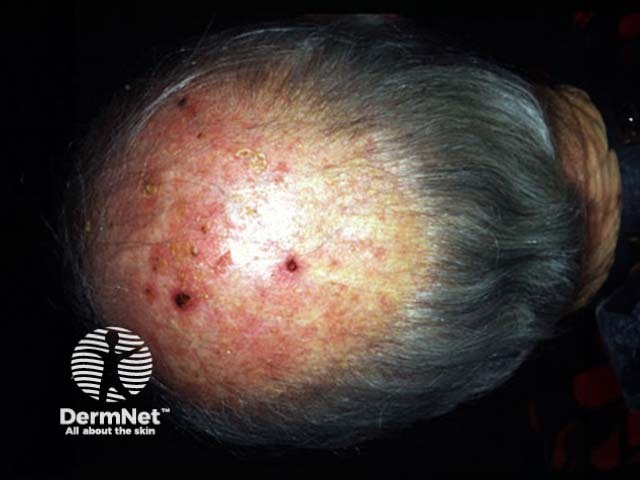Main menu
Common skin conditions

NEWS
Join DermNet PRO
Read more
Quick links
For each of the ten cases, study the image(s) and then answer the questions. You can click on the image to view a larger version if required.
Each case should take approximately five minutes to complete. There is a list of suggested further reading material at the end of the quiz.
When you finish the quiz, you can download a certificate.

What are these lesions?
Solar (actinic) keratoses. Bald men of European origin frequently develop solar keratoses on the scalp, particularly if they have worked outdoors without wearing a hat.
What management would you advise?
Solar keratoses are precursors for invasive squamous cell carcinoma. They are also uncomfortable and unsightly. It is desirable to eradicate them, but not always practical. The patient with solar keratoses should be advised to have a full skin examination from time to time. Recommend sun protection: avoid working in midday sun; wear a hat, long sleeves and trousers; apply sunscreen to uncovered skin. Explain that invasive skin cancer may present as a growing lump or a sore that doesn't heal and should generally be surgically removed. In most cases, treat palpable lesions by freezing with liquid nitrogen. This may need repeating a few weeks later. Consider whether lesions that fail to respond could be squamous cell or basal cell cancers; refer to a dermatologist or biopsy these. Thick solar keratoses can be shaved or scraped off. Patients with diffuse solar keratoses should see a dermatologist with a view to a course of topical 5-fluorouracil (5-FU) treatment. Trichloracetic acid medium depth chemical peels and laser resurfacing are also available to improve photo-damaged skin, but are less effective than 5-FU for solar keratoses. Promising new treatments for solar keratoses include the immune modulating agent imiquimod cream and topical photodynamic therapy (PDT).